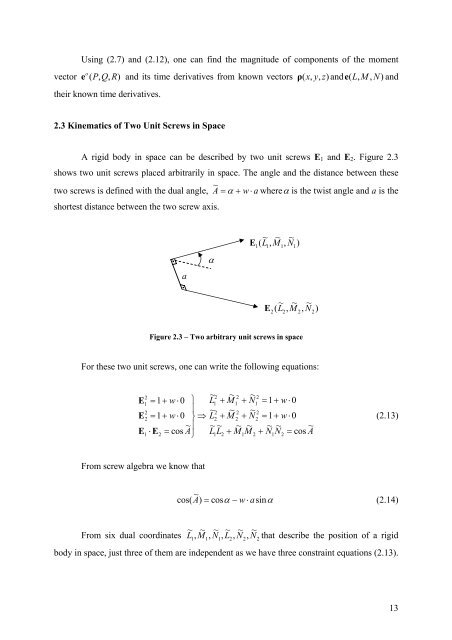Kinematic and Dynamic Analysis of Spatial Six Degree of Freedom ...
Kinematic and Dynamic Analysis of Spatial Six Degree of Freedom ...
Kinematic and Dynamic Analysis of Spatial Six Degree of Freedom ...
You also want an ePaper? Increase the reach of your titles
YUMPU automatically turns print PDFs into web optimized ePapers that Google loves.
Using (2.7) <strong>and</strong> (2.12), one can find the magnitude <strong>of</strong> components <strong>of</strong> the moment<br />
o<br />
vector e ( P,<br />
Q,<br />
R)<br />
<strong>and</strong> its time derivatives from known vectors ρ( x,<br />
y,<br />
z)<br />
<strong>and</strong> e( L,<br />
M , N)<br />
<strong>and</strong><br />
their known time derivatives.<br />
2.3 <strong>Kinematic</strong>s <strong>of</strong> Two Unit Screws in Space<br />
A rigid body in space can be described by two unit screws E1 <strong>and</strong> E2. Figure 2.3<br />
shows two unit screws placed arbitrarily in space. The angle <strong>and</strong> the distance between these<br />
~<br />
two screws is defined with the dual angle, A = α + w ⋅ a whereα is the twist angle <strong>and</strong> a is the<br />
shortest distance between the two screw axis.<br />
Figure 2.3 – Two arbitrary unit screws in space<br />
For these two unit screws, one can write the following equations:<br />
2<br />
~ 2 ~ 2 ~ 2<br />
E = 1+<br />
w ⋅ 0 ⎫ L<br />
1<br />
1 + M1<br />
+ N1<br />
= 1+<br />
w⋅<br />
0<br />
2 ⎪ ~ 2 ~ 2 ~ 2<br />
E2<br />
= 1+<br />
w ⋅ 0 ⎬ ⇒ L2<br />
+ M 2 + N2<br />
= 1+<br />
w⋅<br />
0<br />
~ ⎪ ~ ~ ~ ~ ~ ~ ~<br />
E1<br />
⋅ E2<br />
= cos A⎭<br />
L1L2<br />
+ M1M<br />
2 + N1N<br />
2 = cos A<br />
From screw algebra we know that<br />
a<br />
α<br />
~ ~ ~<br />
L , M , N )<br />
1(<br />
1 1 1<br />
(2.13)<br />
~<br />
cos( A) = cosα<br />
− w ⋅ asinα<br />
(2.14)<br />
~ ~ ~ ~ ~ ~<br />
From six dual coordinates L1, M1,<br />
N1,<br />
L2,<br />
N2,<br />
N2<br />
that describe the position <strong>of</strong> a rigid<br />
body in space, just three <strong>of</strong> them are independent as we have three constraint equations (2.13).<br />
E<br />
E<br />
~ ~ ~<br />
L , M , N )<br />
2(<br />
2 2 2<br />
13
















